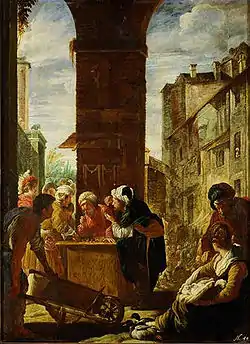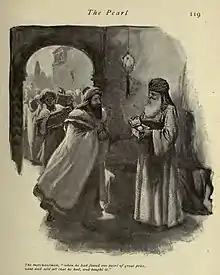Parable of the Pearl
The Parable of the Pearl (also called the Pearl of Great Price) is one of the parables of Jesus. It appears in Matthew 13:45–46 and illustrates the great value of the Kingdom of Heaven.

This is the penultimate parable in Matthew 13, coming just before the Parable of the Dragnet. It immediately follows the Parable of the Hidden Treasure, which has a similar theme. It does not appear in the other synoptic gospels,[1] but a version of this parable does appear in the non-canonical Gospel of Thomas, Saying 76.[2] The parable has been depicted by artists such as Domenico Fetti.
The parable reads as follows:
Again, the kingdom of heaven is like unto a merchant man, seeking goodly pearls: Who, when he had found one pearl of great price, went and sold all that he had, and bought it.
— Matthew 13:45-46, King James Version
Interpretation

This parable is generally interpreted as illustrating the great value of the Kingdom of Heaven. Theologian E. H. Plumptre, in Anglican bishop Charles Ellicott's Commentary, notes that:
"the caprices of luxury in the Roman empire had given a prominence to pearls, as an article of commerce, which they had never had before, and have probably never had since. They, rather than emeralds and sapphires, were the typical instance of all costliest adornments (Matthew 7:6; 1 Timothy 2:9). The story of Cleopatra and the fact that the opening of a new pearl market was one of the alleged motives which led the Emperor Claudius to invade Britain, are indications of the value that was then set on the “goodly pearls” of the parable."[3]
Theologian John Nolland likewise notes that pearls at that time had a greater value than they do today,[4] and it thus has a similar theme to its partner, the parable of the hidden treasure. Nolland comments that it shares with that parable the notions of "good fortune and demanding action in attaining the kingdom of heaven",[4] but adds in this case the notion of "diligent seeking".[4]
The valuable pearl is the "deal of a lifetime" [4] for the merchant in the story. However, those who do not believe in the kingdom of heaven enough to stake their whole future on it are unworthy of the kingdom.[5]
This interpretation of the parable is the inspiration for a number of hymns, including the anonymous Swedish hymn Den Kostliga Pärlan (O That Pearl of Great Price!), which begins:
O that Pearl of great price! have you found it?
Is the Savior supreme in your love?
O consider it well, ere you answer,
As you hope for a welcome above.
Have you given up all for this Treasure?
Have you counted past gains as but loss?
Has your trust in yourself and your merits
Come to naught before Christ and His cross?[6]
A less common interpretation of the parable is that the merchant represents Jesus, and the pearl represents the Christian Church.[7] This interpretation would give the parable a similar theme to that of the Parable of the Lost Sheep, the Lost Coin, and the Prodigal Son.
Pope Pius XII used the phrase to describe virginity.[8]
"Pearl of Great Price" is the title of a selection of Mormon writings, one of the standard works of The Church of Jesus Christ of Latter-day Saints and some other Latter Day Saint denominations.

Gospel of Thomas
A version of the parable also appears in the Gnostic Gospel of Thomas (Saying 76):[2]
Jesus said, "The Father's kingdom is like a merchant who had a supply of merchandise and found a pearl. That merchant was prudent; he sold the merchandise and bought the single pearl for himself. So also with you, seek his treasure that is unfailing, that is enduring, where no moth comes to eat and no worm destroys."
— Gospel of Thomas 76, Patterson/Meyer translation
This work's version of the parable of the Hidden Treasure appears later (Saying 109), rather than immediately preceding, as in Matthew.[9] However, the mention of a treasure in Saying 76 may reflect a source for the Gospel of Thomas in which the parables were adjacent,[9] so that the original pair of parables has been "broken apart, placed in separate contexts, and expanded in a manner characteristic of folklore."[9] In Gnostic thought the pearl may represent Christ or the true self.[9] In the Gnostic Acts of Peter and the Twelve, found with the Gospel of Thomas in the Nag Hammadi library, the travelling pearl merchant Lithargoel is eventually revealed to be Jesus.[10]
Depictions
There have been several depictions of the New Testament parable in art, including works by Domenico Fetti, John Everett Millais and Jan Luyken.
In popular culture
In literature
The parable is referenced in Nathaniel Hawthorne's novel The Scarlet Letter on page 82:
"But she named the infant 'Pearl', as being of great price- purchased with all she had,- her mothers only treasure!"[11]
In other media
The parable is referenced in Star Trek by Scotty at the end of an episode in the original series entitled "The Empath".[12]
See also
- Five Discourses of Matthew
- Life of Jesus in the New Testament
- Ministry of Jesus
- The Pearl of Great Price - one of the standard works in The Church of Jesus Christ of Latter-day Saints.
References
- Cambridge Bible for Schools and Colleges on Matthew 13, accessed 15 January 2017
- Gospel of Thomas: Lamb translation and Patterson/Meyer translation.
- Plumptre, E. H., Ellicott's Commentary for Modern Readers on Matthew 13, accessed 15 January 2017
- John Nolland, The Gospel of Matthew: A commentary on the Greek text, Eerdmans, 2005, ISBN 0-8028-2389-0, pp. 565–566.
- Craig S. Keener, A Commentary on the Gospel of Matthew, Eerdmans, 1999, ISBN 0-8028-3821-9, p. 392.
- The Cyber Hymnal, O That Pearl of Great Price!
- Herbert Lockyer, All the Parables of the Bible, Zondervan, 1988, ISBN 0-310-28111-3, p. 200.
- Pope Pius XII, Sacra Virginitas
- Brad H. Young, The Parables: Jewish Tradition and Christian Interpretation, Hendrickson Publishers, 2008, ISBN 1-59856-303-3, pp. 202–206.
- David Noel Freedman, Allen C. Myers, and Astrid B. Beck, Eerdmans Dictionary of the Bible, Eerdmans, 2000, ISBN 0-8028-2400-5, p. 1041.
- Hawthorne, Nathaniel (1878). The scarlet letter. The Library of Congress. Boston, J.R. Osgood and company.
- "The Star Trek Transcripts - The Empath". www.chakoteya.net. Retrieved 2019-11-23.
External links
 Media related to Parable of the Pearl at Wikimedia Commons
Media related to Parable of the Pearl at Wikimedia Commons